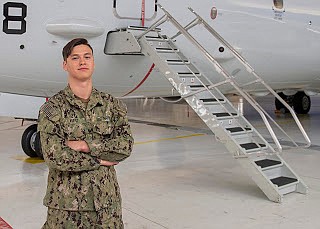Houston Native Patrols Seas from the Air for U.S. Navy
Style Magazine Newswire | 10/22/2019, 10:23 a.m.
By Mass Communication Specialist 2nd Class Jackson G. Brown, Navy Office of Community Outreach
OAK HARBOR, Wash. – Petty Officer 3rd Class Isaac West, a native of Houston, wanted to be more independent and reach for success.
Now, one and a half years after joining the Navy, West serves with the “Screaming Eagles” of Maritime Patrol Squadron (VP) 1, working with the Navy’s cutting-edge maritime patrol and reconnaissance aircraft at Naval Air Station Whidbey Island, Washington.
“Life at the squadron is good for me,” said West. “People are all in high spirits here, and it's a smart, experienced group. My supervisors know their stuff really well.”
West, a 2017 graduate of Woodlands College Park High School, is an aviation structural mechanic with VP-1, a high-tech maritime patrol and reconnaissance squadron tasked with monitoring the world’s oceans in the state-of-the-art P-8A “Poseidon.”
“I work on the structure of the plane, which is up to 90 percent of the aircraft,” said West. “I work on the landing gear, tires and anything powered by hydraulics. It's a versatile job.”
West credits success in the Navy to many of the lessons learned in Houston.
“The diversity in Houston introduced me to a bunch of different types of people and cultures, and the Navy is full of people from everywhere, and that has been very enriching for me,” said West.
VP-1's primary mission is to conduct maritime patrol and reconnaissance as well as long-range anti-submarine warfare, anti-surface warfare and intelligence gathering missions. They deploy around the world to monitor the world’s oceans wherever they are needed.
The P-8A Poseidon, the Navy’s newest maritime, patrol and reconnaissance aircraft, is a replacement aircraft for the legacy P-3C “Orion”. According to Navy officials, leveraging the experience and technology of the successful P-3C “Orion” with the needs of the fleet, the P-8A is designed to be combat-capable, and to improve an operator’s ability to efficiently conduct anti-submarine warfare; anti-surface warfare; and intelligence, surveillance, and reconnaissance missions.
As the Navy transitions to the full capacity with the P-8A “Poseidon”, the aircraft continues the work- horse tradition established by the P-3C “Orion”. The P-8A has a planned state-of-the-art open architecture mission system and next-generation sensors. These capabilities give warfighters added protection. The aircraft empowers the fleet with more combat capability, responsiveness, and interoperability with traditional manned forces and evolving unmanned sensors. The P-8A “Poseidon” has significant growth potential, with planned, phased-in technological improvements that extend global reach, payload capacity and higher-operating altitude.
“The P-8 is commonly used by airlines in the civilian world, but the Navy was able to take it and make a very versatile anti-submarine platform with it,” said West.
Serving in the Navy means West is part of a world that is taking on new importance in America’s focus on rebuilding military readiness, strengthening alliances and reforming business practices in support of the National Defense Strategy.
A key element of the Navy the nation needs is tied to the fact that America is a maritime nation, and that the nation’s prosperity is tied to the ability to operate freely on the world’s oceans. More than 70 percent of the Earth’s surface is covered by water; 80 percent of the world’s population lives close to a coast; and 90 percent of all global trade by volume travels by sea.
“Our priorities center on people, capabilities and processes, and will be achieved by our focus on speed, value, results and partnerships,” said Secretary of the Navy Richard V. Spencer. “Readiness, lethality and modernization are the requirements driving these priorities.”
Though there are many ways for sailors to earn distinction in their command, community, and career, West is most proud of being announced Sailor of the Week in July of 2019.
“I was putting in a lot of hard work with getting qualified in my job, and staying motivated for that,” said West. “It was great to receive recognition for that.”
As a member of one of the U.S. Navy’s most relied upon assets, West and other sailors know they are part of a legacy that will last beyond their lifetimes contributing to the Navy the nation needs.
“Serving in the Navy means being a part of that one percent of people who are willing to go out and do the work that most aren't willing to do, and that's an honor to me,” said West.




